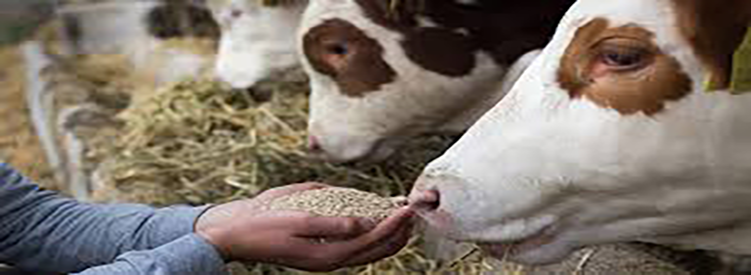


Apart from this feed and fodder, occasionally the cows are fed with jaggery or fresh vegetables donated by devotees.Fresh drinking water is offered to cows two times a day, once around 10 AM in the morning and again around 5 PM in the evening. Currently drinking water is provided in their feeding tubs or buckets, however we started installing steel water bins (gangalas), 1 between
every 2 cows, so that fresh drinking water will be available to the cows round the clock.Dana is a kind of feed given in the morning around 6 AM. The contents of dana include thoor dal husk, rice bran, wheat husk, and cotton seed cake which are very nutritious and high in proteins. All the contents are mixed in required quantities in a tub and soaked in water the previous evening so that it will be ready to be fed the next morning.Kutti is dry, chopped corn plants and it is offered to the cattle at 12 PM.
Fresh green fodder grass is offered to the cattle around 1 PM. The grass is chopped into small pieces with a chopping machine so that it is easy to eat and used efficiently with less wastage. This green fodder grass is grown in 10 acres of ashram land taken on lease for the sake of cattle and when we fall short of green fodder we purchase to feed the cows.
It costs Rs. 151/- per day per Go:ma:ta to feed the above mentioned 3 types of feed and fodder. Devotees may donate for the feed and fodder on a one-time basis, monthly basis, or yearly basis
Dana is a kind of feed given in the morning around 6 AM. The contents of dana include thoor dal husk, rice bran, wheat husk, and cotton seed cake which are very nutritious and high in proteins. All the contents are mixed in required quantities in a tub and soaked in water the previous evening so that it will be

ready to be fed the next morning.Kutti is dry, chopped corn plants and it is offered to the cattle at 12 PM.Fresh green fodder grass is offered to the cattle around 1 PM. The grass is chopped into small pieces with a chopping machine so that it is easy to eat and used efficiently with less wastage. This green fodder grass is grown in 10 acres of ashram land taken on lease for the sake of cattle and when we fall short of green fodder we purchase to feed the cows.